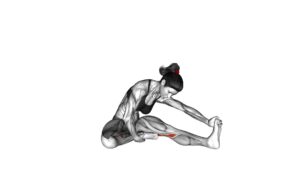Kneeling Single Hamstring Curl (female) – Video Exercise Guide & Tips

Are you looking to strengthen and tone your hamstrings? Then the Kneeling Single Hamstring Curl is the exercise for you.
Watch This Exercise Video
In this video exercise guide, we'll show you the proper form and technique to maximize your results.
Plus, we'll share variations and progressions to challenge yourself and common mistakes to avoid.
Get ready to feel the burn and take your hamstring workout to the next level with this effective exercise.
Let's get started!
Key Takeaways
- The kneeling single hamstring curl helps prevent hamstring strains or tears and provides stability to the knee joint.
- It enhances lower body stability and improves athletic performance.
- The exercise strengthens the hamstrings, targets the glutes, and engages the core muscles for improved balance and stability.
- There are variations and progressions to challenge yourself and maximize the effectiveness of the exercise.
Benefits of the Kneeling Single Hamstring Curl
Discover the numerous benefits of incorporating the Kneeling Single Hamstring Curl into your workout routine. This exercise is highly effective in injury prevention and muscle activation.
One of the key benefits of the Kneeling Single Hamstring Curl is its ability to prevent injuries. By targeting the hamstrings, this exercise helps strengthen these muscles, reducing the risk of strains or tears. Strong hamstrings also provide stability to the knee joint, which further prevents injuries during physical activities or sports.
Additionally, the Kneeling Single Hamstring Curl is excellent for muscle activation. This exercise specifically targets the hamstring muscles, engaging them fully throughout the movement. By focusing on these muscles, you can enhance their strength and improve overall lower body stability.
Furthermore, by incorporating the Kneeling Single Hamstring Curl into your workout routine, you can improve your athletic performance. Stronger hamstrings provide better power and explosiveness, which is crucial for activities like running, jumping, and sprinting.
Proper Form and Technique for the Exercise
To perform the Kneeling Single Hamstring Curl with proper form and technique, you should position yourself on a hamstring curl machine. Start by adjusting the machine to fit your body height and ensure that your knees are comfortably resting on the padded support. Place your hands on the handles for stability.
Now, let's address some common misconceptions about the kneeling single hamstring curl. One misconception is that you need to use heavy weights to see results. However, this exercise is more about targeting the hamstrings and building strength rather than lifting heavy. Focus on using a weight that allows you to perform the exercise with proper form and control.
To incorporate the kneeling single hamstring curl into your leg day routine, start by performing 3 sets of 10-12 repetitions. This exercise can be done at the beginning or towards the end of your leg workout, depending on your preference. Remember to warm up your muscles before starting and stretch afterwards to prevent any potential injuries.
Variations and Progressions to Challenge Yourself
Try out different variations and progressions to challenge yourself during the kneeling single hamstring curl exercise. Here are some advanced modifications and equipment options that you can incorporate into your workout routine:
- Resistance Band Variation: Attach a resistance band to a stable anchor point and loop it around your ankle. This will add extra resistance to the exercise, making it more challenging for your hamstring muscles.
- Stability Ball Variation: Place a stability ball underneath your calves instead of using a bench or pad. This will require more stability and core engagement, intensifying the workout for your hamstrings.
- Single-Leg Variation: Perform the exercise with only one leg at a time. This will increase the difficulty by focusing all the workload on a single leg, improving strength and stability.
- Weighted Variation: Hold a dumbbell or kettlebell in your hands while performing the exercise. This will add additional resistance, forcing your hamstrings to work harder.
When incorporating these variations, make sure to choose a weight or resistance level that challenges you, but still allows you to maintain proper form. Remember to listen to your body and gradually increase the difficulty as you become stronger and more comfortable with the exercise.
Common Mistakes to Avoid During the Exercise
Avoiding common mistakes is crucial when performing the kneeling single hamstring curl exercise. Making these mistakes can't only hinder your progress but also increase the risk of injury. To ensure you're performing the exercise correctly and safely, here are some mistake corrections and injury prevention tips.
One common mistake is using momentum instead of relying on your hamstring muscles to curl the weight. To correct this, focus on maintaining control throughout the entire movement and avoid swinging your leg.
Another mistake is lifting your hips off the pad, which puts unnecessary strain on your lower back. Make sure to keep your hips firmly pressed against the pad throughout the exercise.
Additionally, it's important to avoid hyperextending your knee at the end of the movement. This can strain the knee joint and potentially lead to injury. Instead, aim for a controlled and smooth movement, stopping just short of full extension.
To prevent injury, always warm up before performing the kneeling single hamstring curl exercise. This helps to increase blood flow and loosen up the muscles. It's also important to use an appropriate weight that challenges you without compromising your form.
By avoiding these common mistakes and practicing proper form, you can maximize the effectiveness of the kneeling single hamstring curl exercise while minimizing the risk of injury.
Now, let's move on to the next section and discover some tips for maximizing your results with the kneeling single hamstring curl.
Tips for Maximizing Your Results With the Kneeling Single Hamstring Curl
Maximize your results with the kneeling single hamstring curl by incorporating proper form and gradually increasing the weight. Here are some tips to help you maximize the effectiveness of this exercise and avoid injury:
- Maintain proper form: Keep your back straight and your core engaged throughout the movement. This will help target your hamstrings more effectively and reduce the risk of strain or injury.
- Start with lighter weights: It's important to start with a weight that challenges you but still allows you to maintain proper form. Gradually increase the weight as your strength and stability improve.
- Control the movement: Focus on controlling both the lifting and lowering phases of the exercise. Avoid using momentum to swing the weight up or allow it to drop down quickly. This will ensure that your hamstrings are doing the work and prevent unnecessary strain on your muscles and joints.
- Listen to your body: Pay attention to any discomfort or pain during the exercise. If you experience any sharp or intense pain, stop the exercise immediately and consult with a healthcare professional. It's better to be safe than sorry when it comes to avoiding injury.
Frequently Asked Questions
What Are Some Alternative Exercises That Target the Same Muscles as the Kneeling Single Hamstring Curl?
Looking for alternative exercises to target your hamstring muscles?
There are several variations of the kneeling single hamstring curl that you can try. These exercises focus on the same muscles and provide a great workout.
Try incorporating exercises like the Romanian deadlift, glute bridge, or stability ball hamstring curl into your routine. These exercises will help strengthen and tone your hamstrings, giving you the results you're looking for.
Keep pushing yourself and you'll see progress in no time.
How Often Should I Incorporate the Kneeling Single Hamstring Curl Into My Workout Routine?
To determine how often you should incorporate the kneeling single hamstring curl into your workout routine, consider your fitness goals and current level of strength. As a general guideline, aim for two to three sessions per week, allowing for at least one day of rest in between.
It's important to vary your exercises to target all muscles effectively, so consider incorporating other hamstring exercises like deadlifts or glute bridges into your routine.
Can the Kneeling Single Hamstring Curl Be Modified for Individuals With Knee or Hip Injuries?
Yes, the kneeling single hamstring curl can be modified for individuals with knee or hip injuries. By reducing the range of motion or using lighter weights, you can still benefit from this exercise while protecting your joints.
This modification allows you to strengthen your hamstrings without putting excessive strain on your knees or hips. It's important to consult with a fitness professional or physical therapist to ensure you're performing the modified exercise correctly and safely.
Is It Necessary to Use a Resistance Band or Can the Exercise Be Performed Without One?
To effectively perform the kneeling single hamstring curl, it isn't necessary to use a resistance band.
However, incorporating a resistance band can provide added benefits such as increased resistance and muscle activation.
Without the band, you can still perform variations of this exercise by adjusting your body positioning or using other equipment like a stability ball.
These variations target the hamstring muscles while also reducing stress on the knees and hips.
How Long Should I Hold the Contraction at the Top of the Movement During the Kneeling Single Hamstring Curl?
To properly perform the kneeling single hamstring curl, it's important to know how long to hold the contraction at the top of the movement. This will help maximize the effectiveness of the exercise.
Avoid rushing through the movement and instead, aim to hold the contraction for about one to two seconds at the top. This will ensure that your hamstring muscles are fully engaged and working to their full potential.
Conclusion
Incorporating the kneeling single hamstring curl into your workout routine can offer numerous benefits, such as strengthening your hamstrings and improving overall lower body stability. By maintaining proper form and technique, you can ensure optimal results and minimize the risk of injury.
Additionally, challenging yourself with variations and progressions can help you continue to progress and see continued improvements. Avoiding common mistakes and following these tips can further enhance your results with this exercise.

Author
Years ago, the spark of my life’s passion ignited in my mind the moment I stepped into the local gym for the first time. The inaugural bead of perspiration, the initial endeavor, the very first surge of endorphins, and a sense of pride that washed over me post-workout marked the beginning of my deep-seated interest in strength sports, fitness, and sports nutrition. This very curiosity blossomed rapidly into a profound fascination, propelling me to earn a Master’s degree in Physical Education from the Academy of Physical Education in Krakow, followed by a Sports Manager diploma from the Jagiellonian University. My journey of growth led me to gain more specialized qualifications, such as being a certified personal trainer with a focus on sports dietetics, a lifeguard, and an instructor for wellness and corrective gymnastics. Theoretical knowledge paired seamlessly with practical experience, reinforcing my belief that the transformation of individuals under my guidance was also a reflection of my personal growth. This belief holds true even today. Each day, I strive to push the boundaries and explore new realms. These realms gently elevate me to greater heights. The unique combination of passion for my field and the continuous quest for growth fuels my drive to break new ground.



